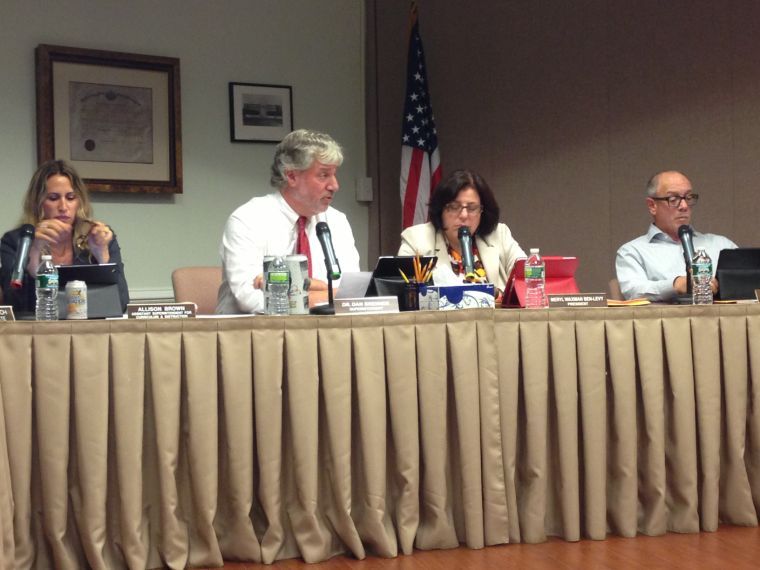The Roslyn School District Board of Education on Thursday discussed the best way to approach the $34.6 million in improvements recommended for district schools by a consultant with some trustees favoring beginning with a limit and others creating a list in which work would be prioritized.
In addition to its own discussions, the board heard the suggestions of members of its building advisory committee and from Erik Kaeyer, the vice president and design principal of KG&D Architects who last month introduced an overview of possible improvements.
Roslyn Superintendent of Schools Dan Brenner said the district should consider projects of immediate importance as well as those that could pose a problem in the near future if not handled sooner.
“You don’t want to be in a situation where, in five years, you didn’t do it and now we’ve got lights that are falling out of the ceiling because we didn’t do it because we didn’t see that in five years that was going to be the case,” Brenner said.
At the board of trustees’ last meeting August 29, Kaeyer presented a Powerpoint presentation that included descriptions and diagrams of different renovations for each school, a financial breakdown of each renovation by school and renderings of similar KG&D projects from recent years. The Powerpoint can be seen on the Roslyn School District Web site.
Included in Kaeyer’s proposals was a $3.828 million project to move the high school’s bus facility off campus to the site of the district’s facilities office, a $3.4 million transformation of the high school’s library into a state-of-the-art media center with green screen filming capability and robotics laboratory technologies and up to $19.5 million in possible infrastructure and site work throughout the district.
Trustees each gave their opinions on the different significant factors the board should consider in determining the types of projects they would favor the district undertaking.
Board of Education President Meryl Waxman Ben-Levy said the district should be looking into projects that could accommodate future technological advancements, while Trustee David Dubner was concerned with how detailed the proposals were for security enhancements.
Trustee Steven Litvack asked Kaeyer to assign a dollar amount to some of the “non-sexy things” in his proposal that had to be tended to immediately. Kaeyer replied that there was approximately $10 million in items that would have to be updated every four to five years.
Board VicePresident Clifford Saffron also clarified comments he made at the board’s last meeting Aug. 29 that suggested the board consider projects that improved the quality of education over design aesthetics, saying a capital plan does not necessarily lend itself to having a direct correlation to a student’s day-to-day experience in the classroom but is still significant to the future of the quality of education a school district is able to provide.
“Our challenge is to kind of thread the needle and weigh everything that’s on the table that clarifies what we think we need to do,” Saffron said.
Gregg Resnick, a contractor who heads the district’s facilities advisory committee, said the board should focus on fixing the infrastructure of the different schools and scale back on projects like the proposed media center at Roslyn High School.
Resnick said many of the project proposals in Kaedar’s presentation match those the committee had thought to be significant, adding that it is beneficial that the district can add and remove line items from the presentation as they arise in conversation.
“The good thing about having it on paper is that you can always scale back on it and can always expand it,” Resnick said.
Brenner said the district should provide builders with direction on how to spend the first $4.5 million approved for infrastructure projects like the removal of Heights Elementary School’s multipurpose “gymatorium,” the completion of the repaving of the rear parking lot at Roslyn High School and a repairing of the track, various improvements to the first floor at Roslyn Middle School and various areas of fencing throughout the district that needs to be replaced.
Brenner also suggested the possibility of the district entering into an energy performance contract that could limit the cost of items like hallway lights and ceilings, windows at Harbor Hill Elementary School that have not been replaced in years and exterior doors.
“We don’t know the liability or feasibility of [an energy performance contract] at this point, but if we could pull this out, that would greatly offset some of these costs,” Brenner said.
The board is in the process of determining a bond referendum proposal by December for a possible district-wide vote in May.
The district has $9 million in its debt service reserve fund, which school officials say could be applied to the cost of repaying bonds and lessening the impact on Roslyn taxpayers.
In addition, the district’s previous bond issue will have matured by 2016, at about the time repayment on new bonds would begin.
District officials have said many of the proposed projects would likely be eligible for state aid, and that Roslyn’s reimbursement rate for capital projects is close to 10 percent.



